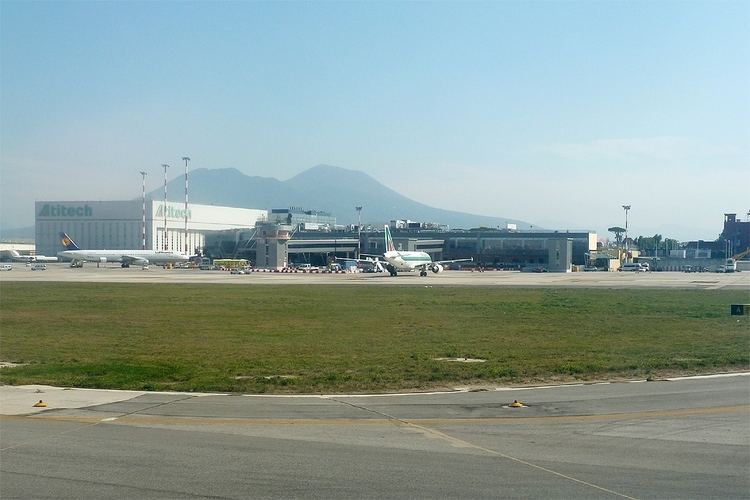Airport type Public Elevation AMSL 294 ft / 90 m Code NAP Yearly aircraft movements 63,935 | Operator GE.S.A.C. Location Capodichino Website www.portal.gesac.it Elevation 90 m Phone +39 081 789 6111 Passenger count 6,775,988 | |
 | ||
Address Viale F. Ruffo di Calabria, 80144 Napoli, Italy Profiles | ||
Landing runway 06 naples international airport nap lirn
Naples International Airport (IATA: NAP, ICAO: LIRN) (Italian: Aeroporto Internazionale di Napoli,) is the international airport serving Naples, Italy. It is located 3.2 NM (5.9 km; 3.7 mi) north-northeast of the city in the Capodichino district of Naples. The airport has two terminal buildings: Terminal 1 is for scheduled flights and Terminal 2, located away from the airfield, is used for charter operations.
Contents
- Landing runway 06 naples international airport nap lirn
- Take off from aeroporto internazionale di napoli naples international airport italy july 2014
- History
- Facilities
- Statistics
- Car
- Bus
- Incidents and accidents
- Use by US military forces
- References
Naples, with a metropolitan population of nearly three million is the largest metropolitan area of Europe which does not serve as a hub nor secondary hub of any airline.
Take off from aeroporto internazionale di napoli naples international airport italy july 2014
History
The district of Capodichino – in the area known as "Campo di Marte" – hosted the first flight exhibitions in Naples in 1910. During the First World War, "Campo di Marte" became a military airport in order to defend the town against Austro-Hungarian and German air attacks. Dedicated to Ugo Niutta, an Italian aviator, Capodichino Airport was a military air base during the Fascist Era and Second World War.
During World War II the airport was used by the United States Army Air Forces extensively during the Italian Campaign. It was used by the Twelfth Air Force as a combat airfield, which stationed the following units at the airport: 79th Fighter Group (January – May 1944, P-40 Warhawk/P-47 Thunderbolt); 47th Bombardment Group (March – April 1944, A-20 Havoc); 33d Fighter Group (April – May 1944, P-40 Warhawk). When the combat units moved out, Air Transport Command used the airport as a major transshipment hub for cargo, transiting aircraft and personnel for the remainder of the war.
Commercial traffic started in 1950. In 1980 GE.S.A.C. ("Gestione Servizi Aeroporto Capodichino") was established to administer the airport; in 1982 it became "Gestione Servizi Aeroporti Campani") and participated in by the City Council, the province of Naples and Alitalia. In 1995 GE.S.A.C. drew up – with BAA assistance – a new master plan, which marked the beginning of a twenty-year development plan. After two years (1997) GE.S.A.C. was the first airport management company in Italy to be privatised: BAA acquires 70% of the share package from the City Council and Province of Naples. In 1998 the "Galleria Napoli" opened, a shopping arcade open 365 days a year inside Terminal 1. In 2002 H.R.H. Prince Charles inaugurated the new departure lounge.
Facilities
The airport has a single runway (orientation: 06/24 – 2,628 m × 45 m (8,622 ft × 148 ft) – resistance: PCN90/F/B/W/T – assistance: PAPI, ILS) in bituminous conglomerate and concrete, with one taxiway. There is one apron with 29 stands, 9 of which self-maneuvering and the remaining Push Back. The airport is class 4D ICAO and has the classification of military airport opened to commercial air traffic 24 hours/day.
The airport management company is fully responsible for managing the airport and coordinating and control activities of all the private operators present in the airport. Capodichino hosts some aeronautical industrial activities, like Atitech, Alenia Aeronautica, Aeronavali, Tecnam Costruzioni Aeronautiche.
Statistics
Annual passenger statistics from 2000 through 2016:
Car
Capodichino is easily accessible from all the city thanks to the exit of the so-called "Tangenziale", an urban highway (A56) connecting the city of Naples to metropolitan area and highways to Rome (A1), Salerno (A3) and Bari (A16). Fixed taxi rates are in use for the main destinations within the city limits of Naples from Airport to: Naples Centre, Molo Beverello (Port), Mergellina (Hydrofoils to Capri and Ischia Islands).
Bus
Bus line 3S and Alibus, operated by ANM, connect the airport to Piazza Garibaldi and Piazza Municipio. Distance airport/centre city is about 7 km (4.3 mi). The airport is also connected to Avellino, Benevento, Caserta, Sorrento, Salerno and Serre.
Incidents and accidents
Use by U.S. military forces
U.S. military forces are present on this site since 1951. Among two other facilities in Naples, Naval Support Activity Naples is a tenant of several buildings in the Northwestern area of the airport. The United States Navy handles military and civilian aircraft on this airport for logistics.
